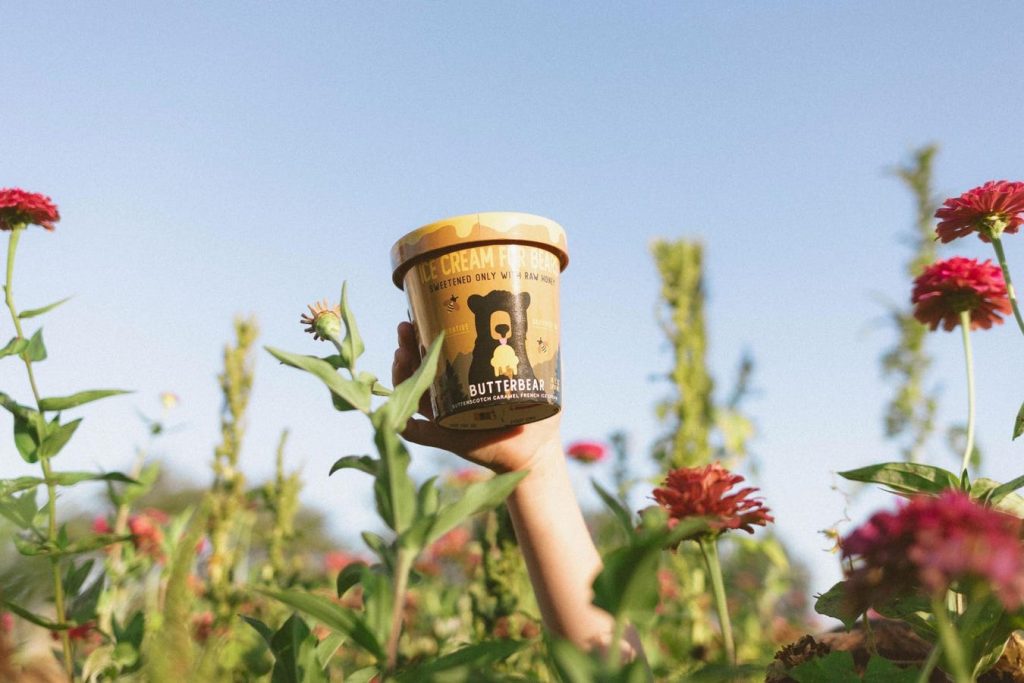Tim Berg is a simple guy.
He likes eating fresh foods and spending time outdoors.
Ice Cream for Bears is Berg’s experiment to prove that nature’s bare gifts are beyond plentiful to satisfy our cravings.
After two years in the wilderness, Ice Cream for Bears is entering thousands of stores, including Kroger banner stores, and rolling out a panoply of grizzly flavors.
“It makes me sad when people think they can’t have things that are delicious because they’re trying to be healthy,” Berg tells me. “Everything behind the Ice Cream for Bears brand is to try and eat things in the form closest to which they were eaten ten thousand years ago.”
Raw, Unfiltered Honey And Pasture-Raised Dairy
As any wild bear would, Ice Cream for Bears strictly sources raw and unfiltered honey as its sole sweetener. The honey never gets heated to extreme temperatures in order to maintain its natural properties. “You have this substitute in nature that is just as potent, if not more, than those other sweeteners,” Berg says. “It’s a rare moment where nature has the answer in spades to what’s been processed.”
Just like watermelon’s peak in the summer and squash’s in autumn, honey is also seasonal and takes on the characteristics of its geography. So as opposed to overly-standardized honey, customers may notice slight changes in taste when eating Ice Cream for Bears depending on the time of year.
The mild honey blend is sourced from parts of Europe and South America. The processing, as opposed to any ultra-processing, simply filters out beeswax and other contaminants. “All of our honey is tested to confirm origin, tested for foreign sugar contamination, tested to confirm enzyme activity is high and has not been degraded by heat,” Berg says.
Honey is rare to find as a sweetener in ice cream, largely because it’s a more expensive sweetener and its water content can make it difficult to work with. But once perfected, it can be the secret strategy for a velvety consistency. “Honey is an antifreeze,” Berg explains. “[Our ice cream]
has a softness to it…that is all honey.”
In terms of its dairy, Berg wouldn’t compromise on sourcing grass-fed. “Thats what cows are supposed to be eating,” he says. He found reliable partners in Working Cows Dairy in Slocomb, Alabama. The organic farm, which is also Certified Grassfed by A Greener World, provides a custom dairy blend with a high milkfat percentage to Ice Cream for Bears.
“We’re not making this for anybody else,” says Jonny de Jong, whose family owns and operates Working Cows Dairy, which also performs all of the dairy processing on the estate. “[Ice Cream for Bears is] trying to be different and simple and that is a challenge, but also creates a remarkable product.”
Working Cows Dairy is working towards gaining a certification for its regenerative agriculture practices. As a farm with high animal welfare and grazing standards, these cattle have constant access to pasture. Rotational grazing on the farm allows the grass’ roots to keep growing once it’s eaten to help maintain a strong root structure, and in return, healthy soil. “[Berg] understands that we’re going to face challenges working with nature,” de Jong says. “They’re supporting us as a local farm, so that means a lot to us down here.”
Other than dairy and honey, the only ingredient in the base of Ice Cream for Bears is egg, which makes it a French ice cream. Other ingredients for individual flavors include extracts like vanilla or orange for the Roar-ange Cream flavor, cacao nibs for Chocturnal, coffee for Bearista and vanilla bean for Queen & Bean.
This fall, Ice Cream for Bears will add three new flavors to its lineup: Dough Bear (cookie dough made from dates), Churro and Burrow (cinnamon) and Cubbies & Cream (cookies & cream).
“As we grow,” Berg says, “I want our sourcing, our supply chain to get even better.”
Scoop School
Berg has always had an affinity for the outdoors and connecting with nature, which has inspired his personal diet of minimal processed foods. But still, he would battle his sweet tooth. “I was looking for something sweet and delicious that would fill this sort-of ancestral criteria that I formed for myself in my way of eating,” he says.
Ice Cream for Bears began with a flimsy ice cream maker while Berg earned a Master’s in entrepreneurship at Washington University in St. Louis, before a pitch competition changed its trajectory. “This guy–Steve Christensen, one of my favorite people in the world–was invited to be a judge,” Berg says. “He owns this place in St. Louis called Scoop School.” Berg finally got his hands on some commercial equipment when Christensen invited him to Scoop School, which teaches the tricks and trades of opening an ice cream shop.
The moment he graduated, Berg sold his first pint of Ice Cream for Bears, beginning with farmers markets in St. Louis, graduating to some local shops. A proud moment was when he was able to upgrade his ice cream maker to a Musso Lussino. Ice Cream for Bears is now made with a co-manufacturer in Wisconsin. In early 2024, about two years later, Ice Cream for Bears landed its first major account with Sprouts Farmers Market.
Ice Cream For Everyone
“It was a wild couple of months,” Berg says about raising money to ramp up production for more than 400 Sprouts stores nationwide. He was still running just on the $8,000 he invested from his own bank account. Ice Cream for Bears is now a permanent staple in Sprouts’ ice cream set.
By the end of 2025, Ice Cream for Bears will be in nearly 5,000 stores nationwide. That’s not just natural grocers like Sprouts and Fresh Thyme Market, but conventional ones like Raley’s and Kroger. Landing on a price point of $7.99, Berg was willing to sacrifice a couple of dollars per pint so that most anyone could access a clean yet awesomely delicious ice cream. “Velocity has really helped us survive on lower margins,” Berg says.
The provocative name helps drive those velocities, making shoppers do a double-take when browsing for ice cream. The simplicity of the name reflects the simplicity of what’s inside and masterfully explains the type of sweetener used. It also leaves an opening for future line extensions, like Hot Fudge for Bears, which will debut soon.
Ice Cream for Bears’ Creative and Marketing Director Tara Berg led the branding effort. “The logo itself is very cartoony and friendly and fun,” she says. Tara, who also happens to be Berg’s sister, has created an entire universe of two-dimensional bears in a range of scenarios where it would be slobbering down honey. “It’s always a marriage of this serious and cool nature imagery, but we make it a little more whimsical.”
That whimsical feeling correlates with the brand’s more blunt tone about ingredients used in our food system. “We are not afraid to call out the things we don’t like in the food industry”, Tara says. “We try to be transparent and authentic and give people a peek behind the curtain because we’re really proud of everything we do and how we source,” she continues. “We want other companies to try to do the same.”
Berg simply wants his product to be an example of what our food system should look like. “This value system that I feel so strongly about has helped me in my own life, and I can share it with people through this product that isn’t asking them to sacrifice anything,” he says. “Everything going into this product is fit for a bear, this icon of the wilderness.”
As the brand likes to say, the future of food is in the past.
Read the full article here









